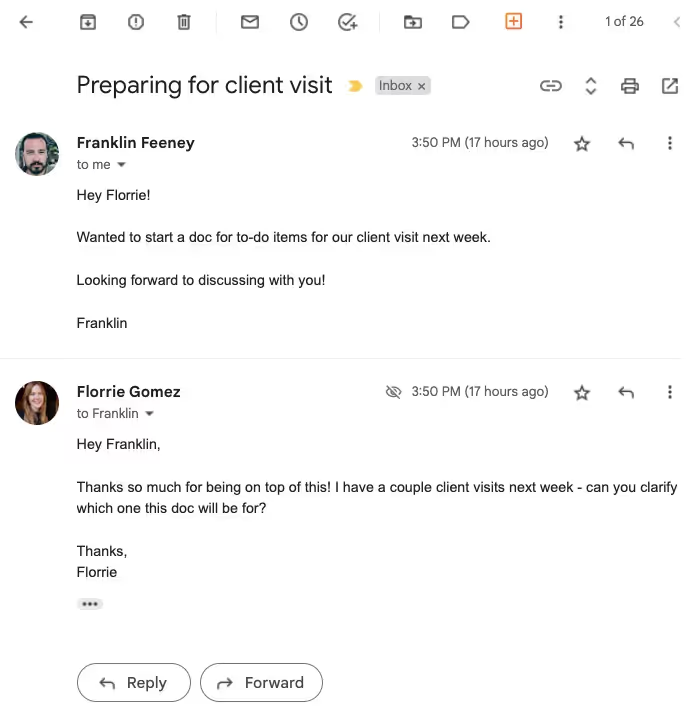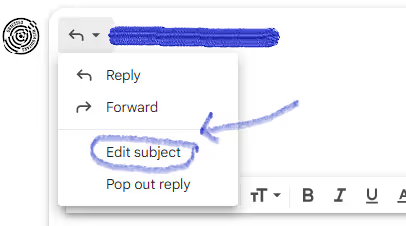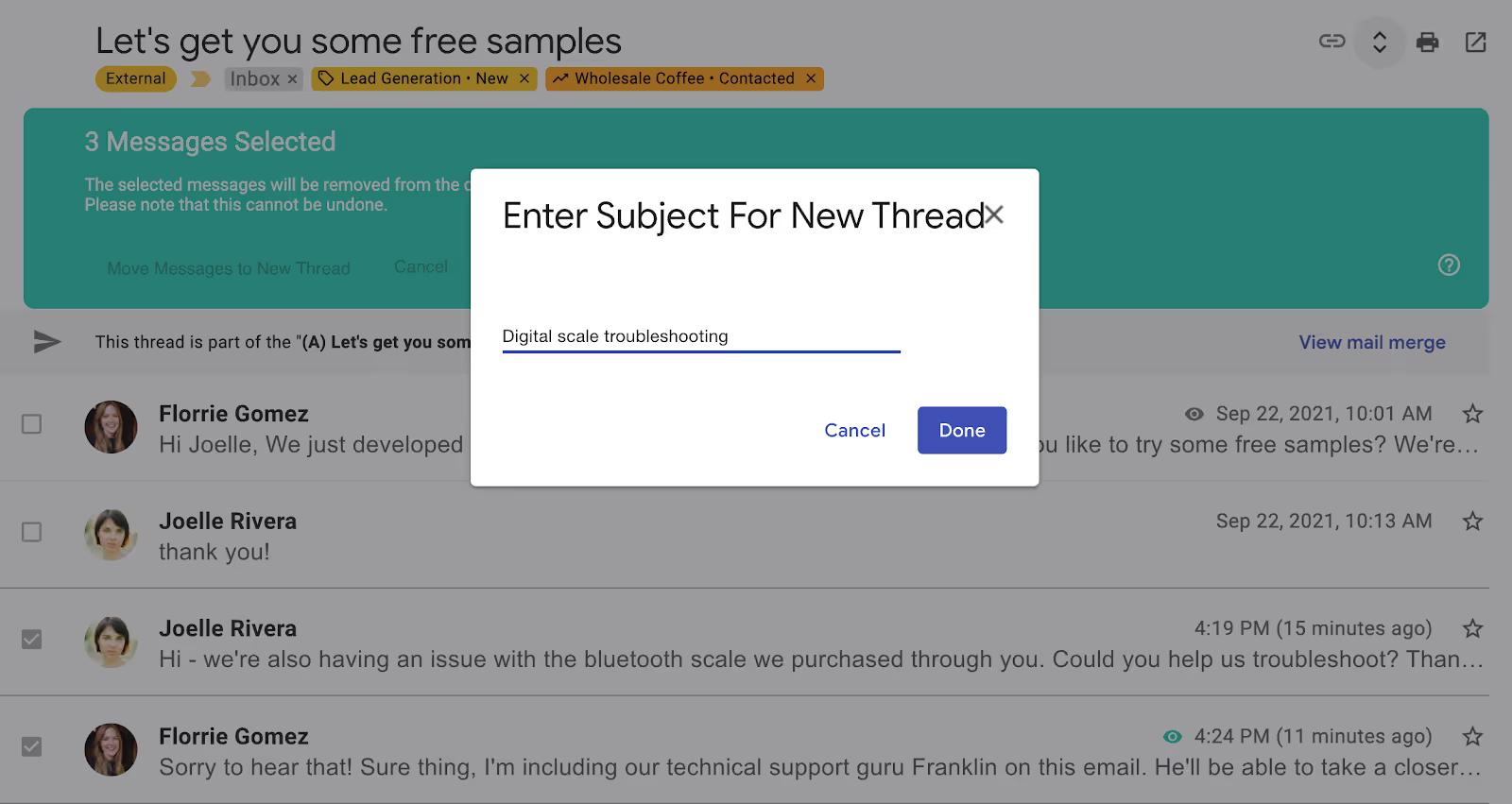How to separate email threads in Gmail
Learn how Gmail's Conversation View groups your emails together and how to separate specific emails into new conversations or threads (with new subject lines) in Gmail.
A common issue in Gmail is that email threads can become long and unwieldy - sometimes bouncing from topic to topic until two parallel conversations are happening in one email, or in some cases new information surfaces that makes the original email topic irrelevant.
In both of these scenarios, changing the subject line of your email can help add clarity and direction to your email thread.
There are two different tools that allow you to do this, and each one has a different outcome with its own benefits.
First, we’ll look at some of the scenarios in which you’d want to change a subject line, and our recommendation for each one. Then, we’ll share step-by-step instructions for each method so you can choose what’s best for your needs.
<div class="anchor-wrapper"><div id="why-is-an-email-subject-line-important" class="anchor-target"></div></div>
An email subject line is the headline of an email, the copy that first appears in the recipient's inbox. While most people often disregard their subject lines, it's actually a handy email feature that can make your email communication more effective and increase engagement.
Here's why you should make the most out of Gmail's subject line:
Tired of sending emails that don't get replies? Maybe it's your subject line.
Recent surveys suggest that 47% of email recipients open an email based on the subject line. So, if you want people to read and respond to your email, create an interesting subject line.
If you're using Gmail for day-to-day email correspondence, then your subject line can be an effective organization tool.
We all know that our Gmail inboxes can become cluttered, especially if we correspond to clients and teammates daily. Fortunately, Gmail has a Label feature allowing you to tag your emails accordingly. By creating filters that look for certain words or phrases in subject lines, you can automatically label and organize your emails in your Gmail inbox.
A clear subject line allows you to use Gmail's Labels without the need to open each email. This expedites your organization process and gives you more time to actually respond to emails instead of just looking for them in your inbox.
Have you ever been too busy to read an entire email thoroughly?
Everyone has experienced that, and a clear subject line allows recipients to note the essential things without spending too much time in their inboxes.
"Meeting rescheduled to the 25th."
"New deadline for the strategy deck: Aug 9."
"Client visiting the office today."
These kinds of subject lines are life savers for busy people.
<div class="anchor-wrapper"><div id="how-gmail-uses-subject-lines-to-create-a-conversation-view" class="anchor-target"></div></div>
Before we explain the two different ways to change subject lines in Gmail, it’s important to understand how Gmail uses subject lines to create an email thread, or conversation view, for your emails.
Many of us take Gmail's conversation view feature for granted, usually considering it to be the default way that our email inboxes work. But conversation view is indeed a feature, and an important one at that.

Gmail’s conversation view takes each individual email - that’s each email you send initially or as a response to somebody else - and groups them chronologically based on subject line.
This means that when you see the subject line “Preparing for client visit” in your inbox, you can click on that one subject line and see every email that’s been sent and received in response.
Without email threading and conversation view, each of those emails would show up in your inbox separately. It would be a mess and the conversation would be hard to follow.
So… why does this matter?
When you change the subject line of an email, it alters the conversation view. Creating a new subject line technically creates a new conversation, or email thread.
The two tactics to change subject lines that we share below each take a slightly different approach and have a slightly different outcome. We'll explain how.
<div class="anchor-wrapper"><div id="why-change-the-subject-line-in-gmail" class="anchor-target"></div></div>
Doesn’t it make sense to leave the subject line alone, so people know your message is continuing an established email chain?
Well, yes. But there are some good reasons you might want to change the subject line.
Let’s say you have an attachment everyone needs to see, or an update that changes the course of the conversation. You can change the subject line to reflect this.
Maybe the original subject line read, “Meeting Notes for February.” You could alter it to read, “UPDATE: Schedule Attached - Meeting Notes for February” to make the thread easier to follow.
Suggestion: <a href="#editSubject">Gmail’s Edit subject line</a>
Perhaps an email thread contained the subject line, “Photo Shoot Friday,” but the photo shoot wasn’t actually on Friday. Changing the subject line will help share the correct information with everybody on the thread.
You might edit it to read, “Photo Shoot THURSDAY.”
Suggestion: <a href="#editSubject">Gmail’s Edit subject line</a>
It’s easy for an email thread to go off the rails. “Q4 milestones review” might quickly turn into a conversation about upcoming milestones for the next year.
To keep things organized, you may want to split the email conversation into separate threads for each topic. When you do so, you can change the subject line for the new thread to refer to upcoming milestones.
Suggestion: <a href="#threadSplitter">Streak’s thread splitter</a>
It’s not uncommon for a sales rep to be working with a lead who suddenly needs help from customer support.
Maybe they’re locked out of their account or are experiencing a technical issue with the product. Whatever it is – the sales rep needs to loop in someone from the support team to resolve the issue and help close the deal.
Once the support rep has been introduced, it can be helpful to split the email into two clear threads: one where the sales rep is negotiating a deal with the customer, and one where the support rep is helping the customer resolve an issue.
When you create a new email thread for the support inquiry, you can change the subject line to be specific to the issue, like “Password reset help”.
Suggestion: <a href="#threadSplitter">Streak’s thread splitter</a>
Conversations with generic subject lines like “Pics” are tough to find when you need to access information in the email or refer to the thread in the future.
To make searching for the thread easier, you might change the subject line to read “Screenshots of new feature launch from October ‘22”
Suggestion: <a href="#editSubject">Gmail’s Edit subject line</a>
<div class="anchor-wrapper"><div id="gmails-edit-subject-line-feature" class="anchor-target"></div></div>
Gmail allows you to change a subject line of an existing email thread when you respond in the thread.
When you do this, you’re actually copying over the existing email thread and creating a new thread with your response and the new subject line.

You’ll end up with two threads in your inbox – one with the old subject line, and one with the new subject line.
All of the emails sent prior to editing the subject line will appear in both threads, but your response will only appear in the new one.

To change the subject line in Gmail and create a duplicate thread:




<div class="anchor-wrapper"><div id="use-streak-to-separate-emails-in-a-thread-and-change-the-subject-line" class="anchor-target"></div></div>
Streak offers another option for editing subject lines in Gmail called our thread splitter tool. It’s included in our free browser extension and allows you to select specific emails from a thread and separate them into a new email thread with a new subject line.
This is especially useful when multiple topics, teams, or processes are involved in one email thread, resulting in parallel conversations.
If you haven’t installed the free Streak extension, head over to the Chrome Web Store or the Mac App Store for Safari users to get started.
Once you have the free Streak extension installed:



Please note that this action cannot be undone.
Once you’ve separated the emails, you’ll find the new email thread with the subject line you entered in your inbox.

<div class="anchor-wrapper"><div id="two-methods-to-change-the-subject-line-in-gmail" class="anchor-target"></div></div>
Editing a subject line in Gmail or using Streak’s thread splitter tool both offer free and simple ways to change the subject line of an existing conversation.
So how to you choose which one to use?
As a rule of thumb:
The ability to split and rename email threads is one tool in your inbox organization arsenal. For more tips and tools, learn how you can add emails to pipelines in Gmail, track views on your sent emails, and more below.
